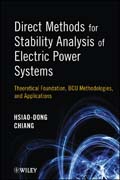
Direct methods for stability analysis of electricpower systems: theoretical foundation, BCU methodologies, and applications
Chiang, Hsiao-Dong
INDICE: Preface. Acknowledgments. 1. Introduction and Overview. 1.1 Introduction. 1.2 Trends of Operating Environment. 1.3 Online TSA. 1.4 Need for New Tools. 1.5 Direct Methods: Limitations and Challenges. 1.6 Purposes of This Book. 2. System Modeling and Stability Problems. 2.1 Introduction. 2.2 Power System Stability Problem. 2.3 Model Structures and Parameters. 2.4 Measurement-Based Modeling. 2.5 Power System Stability Problems. 2.6 Approaches for StabilityAnalysis. 2.7 Concluding Remarks. 3. Lyapunov Stability and Stability Regionsof Nonlinear Dynamical Systems. 3.1 Introduction. 3.2 Equilibrium Points and Lyapunov Stability. 3.3 Lyapunov Function Theory. 3.4 Stable and Unstable Manifolds. 3.5 Stability Regions. 3.6 Local Characterizations of Stability Boundary. 3.7 Global Characterization of Stability Boundary. 3.8 Algorithm to Determine the Stability Boundary. 3.9 Conclusion. 4. Quasi-Stability Regions: Analysis and Characterization. 4.1 Introduction. 4.2 Quasi-Stability Region. 4.3 Characterization of Quasi-Stability Regions. 4.4 Conclusions. 5. Energy Function Theory and Direct Methods. 5.1 Introduction. 5.2 Energy Functions. 5.3 Energy Function Theory. 5.4 Estimating Stability Region Using Energy Functions. 5.5 Optimal Schemes for Estimating Stability Regions. 5.6 Quasi-Stability Region andEnergy Function. 5.7 Conclusion. 6. Constructing Analytical Energy Functions for Transient Stability Models. 6.1 Introduction. 6.2 Energy Functions for Lossless Network-Reduction Models. 6.3 Energy Functions for Lossless Structure-Preserving Models. 6.4 Nonexistence of Energy Functions for Lossy Models. 6.5 Existence of Local Energy Functions. 6.6 Concluding Remarks. 7. Construction of Numerical Energy Functions for Lossy Transient Stability Models. 7.1 Introduction. 7.2 A Two-Step Procedure. 7.3 First Integral-Based Procedure. 7.4 Ill-Conditioned Numerical Problems. 7.5 Numerical Evaluations of Approximation Schemes. 7.6 Multistep Trapezoidal Scheme. 7.7 On the Corrected Numerical Energy Functions. 7.8 Concluding Remarks. 8. Direct Methods for Stability Analysis: An Introduction. 8.1 Introduction. 8.2 A Simple System. 8.3 Closest UEP Method. 8.4 Controlling UEP Method. 8.5 PEBS Method. 8.6 Concluding Remarks. 9. Foundation of the Closest UEP Method. 9.1 Introduction. 9.2 A Structure-Preserving Model. 9.3 Closest UEP. 9.4 Characterization of the Closest UEP. 9.5 Closest UEP Method. 9.6 Improved Closest UEP Method. 9.7 Robustness of the Closest UEP. 9.8 Numerical Studies. 9.9 Conclusions. 10. Foundations of the Potential Energy Boundary Surface Method. 10.1 Introduction. 10.2 Procedure of the PEBS Method.10.3 Original Model and Artifi cial Model. 10.4 Generalized Gradient Systems.10.5 A Class of Second-Order Dynamical Systems. 10.6 Relation between the Original Model and the Artifi cial Model. 10.7
- ISBN: 978-0-470-48440-1
- Editorial: John Wiley & Sons
- Encuadernacion: Cartoné
- Páginas: 494
- Fecha Publicación: 23/11/2010
- Nº Volúmenes: 1
- Idioma: Inglés
